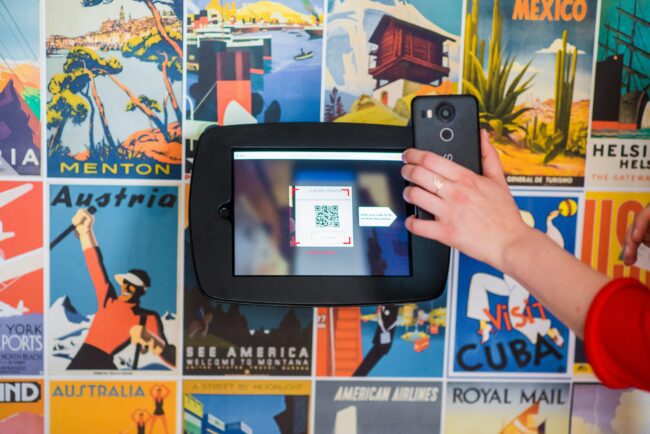Serene Davis once said, “A breach alone is not a disaster, but mishandling it is.” At Gaia Digits, we couldn’t agree more. The need for an efficient management solution is undeniable. Among these, a visitor management solution emerges as a vital component for any and all organizations.
What would happen if an organization didn’t have this type of solution? Undoubtedly, the organization would face heightened security risks, operational inefficiencies, and challenges with compliance.
However, the true cost of neglecting a robust visitor management system often lurks beneath the surface, hidden from plain sight.
In this in-depth post, we delve into the overlooked expenses and risks associated with lacking a valid visitor management solution. Matter-of-factly, it’s imperative to invest in comprehensive management solutions for the success of your organization. Let’s go.
What are Management Solutions?
The term “management solutions” covers a wide range of tools, tech, and strategies designed to optimize processes within an organization. They also enhance efficiency and drive strategic objectives.
Some solutions cover a range of areas such, as HR, operations, finance, and managing facilities.
Fundamentally, management solutions strive to improve workflows. They also boost decision-making and optimize the utilization of resources. Solutions like these work to achieve desired objectives.
Understanding these Solutions:
Management solutions comprise a wide range of software applications, platforms, and methodologies. They’re tailored to align with the needs and objectives of organizations.
Despite variations in scope and functionality across different contexts and industries, these solutions share common traits and aims focused on overcoming challenges and fostering organizational success. Let’s take a closer look at these below:
Enterprise Resource Planning (ERP) Systems:
ERP systems represent comprehensive, integrated software solutions. These systems are engineered to oversee business processes. These include finance, accounting, human resources, supply chain management, and customer relationship management.
ERP systems empower organizations through data centralization and facilitation of cross-functional collaboration. By way of this, they enhance decision-making and attain control over their business processes.
Customer Relationship Management (CRM) Systems:
CRM systems, commonly known as Customer Relationship Management systems are software tools. They’re specifically created to assist companies in handling interactions and relationships, with customers and potential clients.
These platforms usually come equipped with features. They can include managing contacts, automating sales processes, handling marketing tasks, and overseeing customer service operations.
By embracing the capabilities of CRM systems, organizations can enhance customer satisfaction levels, drive sales expansion, and foster long-term loyalty and retention among their clientele.
Human Capital Management (HCM) Systems:
Human Capital Management (HCM) is a type of solution aimed at streamlining various HR processes. These cover employee recruitment, onboarding, performance management, training, and payroll administration.
By automating manual tasks, standardizing processes, and providing insights into workforce data, HCM systems enable organizations to optimize HR operations, enhance employee productivity, and cultivate a high-performing workforce.
Facilities Management (FM) Systems:
FM systems encompass a range of software solutions and technologies aimed at managing and optimizing facilities-related processes. This includes space planning, maintenance management, asset tracking, and environmental sustainability.
By centralizing facility data, automating maintenance workflows, and optimizing space utilization, FM systems help organizations. Solutions like these reduce downtime, cut operational costs, and create safer, more productive workspaces.
So, What’s the Significance of a Management Solution?

Indubitably, there’s a rabbit hole of hidden costs. But before we venture down that, it’s important to understand the significance of these solutions. This is especially the case when we talk about visitor management.
In the past, manual entry, such as sign-in sheets, happened to be the only way to manage visitors.
Flash forward to now with the uptick in technology, and modern businesses have experienced a shift. That shift is geared towards automated visitor management systems.
Here are some of the reasons for that:
Enhanced Security Measures:
Visitor management systems play a pivotal role in bolstering security measures within organizational premises. By implementing robust authentication processes, access controls, and real-time monitoring capabilities, these solutions fortify defenses against unauthorized access and potential security breaches.
The advanced security measures include features, like authentication, facial recognition, and integration. These enhancements help strengthen security protocols by allowing authorized individuals to access areas. Furthermore, these measures boost confidence, among employees, visitors, and stakeholders.
Streamlining Administrative Processes:
When a business approaches administrative tasks the old-fashioned way (manually), it consumes time, is prone to errors, and places a demand on resources.
Management solutions alleviate these burdens by:
- Automating repetitive tasks.
- Reducing paperwork
- Paving the way for smooth communications across all departments.
Essentially, visitor management systems can erase the need for manual ways to sign in. They allow visitors to swiftly check in through self-service kiosks or mobile apps. This is going to speed up the check-in process and reduce the strain on the administrative workload, giving staff time to concentrate on the things that truly matter.
Furthermore, by opting to merge their systems like calendar applications and email services companies can enhance the efficiency of their operations.
Compliance and Regulatory Requirements:
In today’s world companies function in a way that involves strict rules related to visitor access, data privacy, and security standards. Management software offers features to help meet these demands effectively.
Visitor management systems securely capture and store visitor data:
- This allows organizations to maintain accurate records of visitor activity.
- This also enables them to comply with data privacy regulations such as GDPR, CCPA, and HIPAA.
- By implementing access controls and audit trails, these systems also help organizations demonstrate compliance during regulatory audits and inspections.
Furthermore, management solutions often offer customizable features and configurations to adapt to industry-specific regulations and compliance standards, thereby ensuring adherence to legal requirements while minimizing the risk of non-compliance penalties.
Data Analytics and Insights:
Data analytics has become a potent tool for guiding informed decision-making and shaping business strategy. Management solutions harness data analytics capabilities to furnish organizations with valuable insights into visitor behavior, preferences, and trends.
By analyzing visitor demographics, entry/exit patterns, and dwell times, organizations can gain actionable insights to optimize resource allocation, improve operational efficiency, and enhance the overall visitor experience. For example, data analytics may reveal peak visitation hours, enabling organizations to adjust staffing levels or allocate resources accordingly.
Furthermore, insights derived from data empower organizations to pinpoint areas for enhancement, foresee future trends, and make data-informed decisions to maintain a competitive edge. Whether it entails identifying bottlenecks in the check-in process or discovering opportunities for upselling or cross-selling, data analytics is pivotal in fostering ongoing improvement and innovation within the organization.
Modern Solutions Extending Beyond Mere Solutions:
In essence, management solutions encompass a wide range of functionalities and benefits that extend beyond mere administrative convenience.
From enhancing security measures and ensuring compliance with regulatory requirements to providing valuable data insights and improving the overall visitor experience, these solutions play a fundamental role in optimizing organizational operations and driving long-term success.
As organizations navigate evolving business landscapes and security challenges, investing in comprehensive management solutions remains essential for staying competitive, resilient, and future-ready.
Hidden Costs of Neglecting a Valid Visitor Management Solution:

Despite the clear benefits, many organizations fail to recognize the hidden costs associated with neglecting a robust visitor management solution. Let’s take a closer look at what the “catch” is below:
Security Breaches and Liability:
Insufficient visitor management carries a risk of security breaches. Without tracking and authentication, unauthorized individuals could gain access, to areas putting the organizations’ assets, data, and staff in jeopardy. If a security breach occurs the organization may face consequences damage, to its reputation, and significant financial setbacks. This underscores the importance of implementing a management system.
Operational Inefficiencies:
Manual visitor management processes are inherently inefficient and prone to errors.
From manually entering visitor details to issuing access credentials, these tasks consume valuable time and resources, diverting attention from core business activities. Moreover, outdated systems may lack integration capabilities, leading to disjointed workflows and communication gaps between departments.
Consequently, organizations witness diminished productivity and escalated operational expenses. This emphasizes the pressing need for an automated solution.
Compliance Risks:
In today’s regulatory landscape, organizations are subject to various compliance requirements related to visitor access, data privacy, and security protocols. Without a valid visitor management solution in place, meeting these requirements becomes a daunting challenge, exposing the organization to compliance risks and potential penalties.
Whether dealing with GDPR, HIPAA, or industry-specific regulations, failure to comply can lead to severe consequences. This could include fines, legal penalties, and missed business opportunities.
Poor Visitor Experience:
Initial impressions hold significant weight, and the visitor encounter profoundly influences perceptions of the organization. Cumbersome manual check-in procedures, extended wait periods, and navigational confusion may form unfavorable impressions on visitors, thereby affecting the organization’s reputation adversely. Conversely, an effortlessly integrated and streamlined visitor management system elevates the overall experience, leaving visitors with a favorable impression and nurturing positive sentiments toward the organization.
Lack of Data Insights:
Utilizing data to make informed decisions plays a role in propelling business expansion and fostering creativity. However, without a system for managing visitors, companies miss out on information obtained from visitor data. By examining visitor trends, demographics, and actions companies can identify patterns, allocate resources efficiently, and tailor their services to better meet visitor requirements. Lacking access to this information puts organizations at a disadvantage, in the landscape preventing them from using data strategically for their benefit.
Final Word:
Photo by Proxyclick Visitor Management System on Unsplash
Certainly overlooking the expenses associated with not adopting visitor management solutions goes beyond the upfront costs. The repercussions of management solutions can significantly affect an organization’s status and image. Hence it is crucial for organizations to give importance to installing visitor management systems that can effectively tackle these issues.
Various management solutions encompass a range of tools and technologies tailored to meet organizational requirements and hurdles, in different functional domains. From streamlining business operations to enhancing customer interactions, optimizing workforce supervision, or upgrading facility management these solutions are vital for boosting effectiveness.
At Gaia Digits, we’re the leading Canadian Workspace and Facility Management solution for a reason. Our platform provides your organization with a way to take your room and desk schedules digitally. We understand that security risks and operational inefficiencies to compliance present a challenge. As one of the most flexible and configurable solutions for scheduling, we’re here for you. We feature room & desk booking, employee screening, and more.
Investing in the solution enables companies to improve security measures, optimize processes, and provide top-notch visitor experiences all while reducing expenses and potential risks. This approach ensures lasting success and sustainability.

